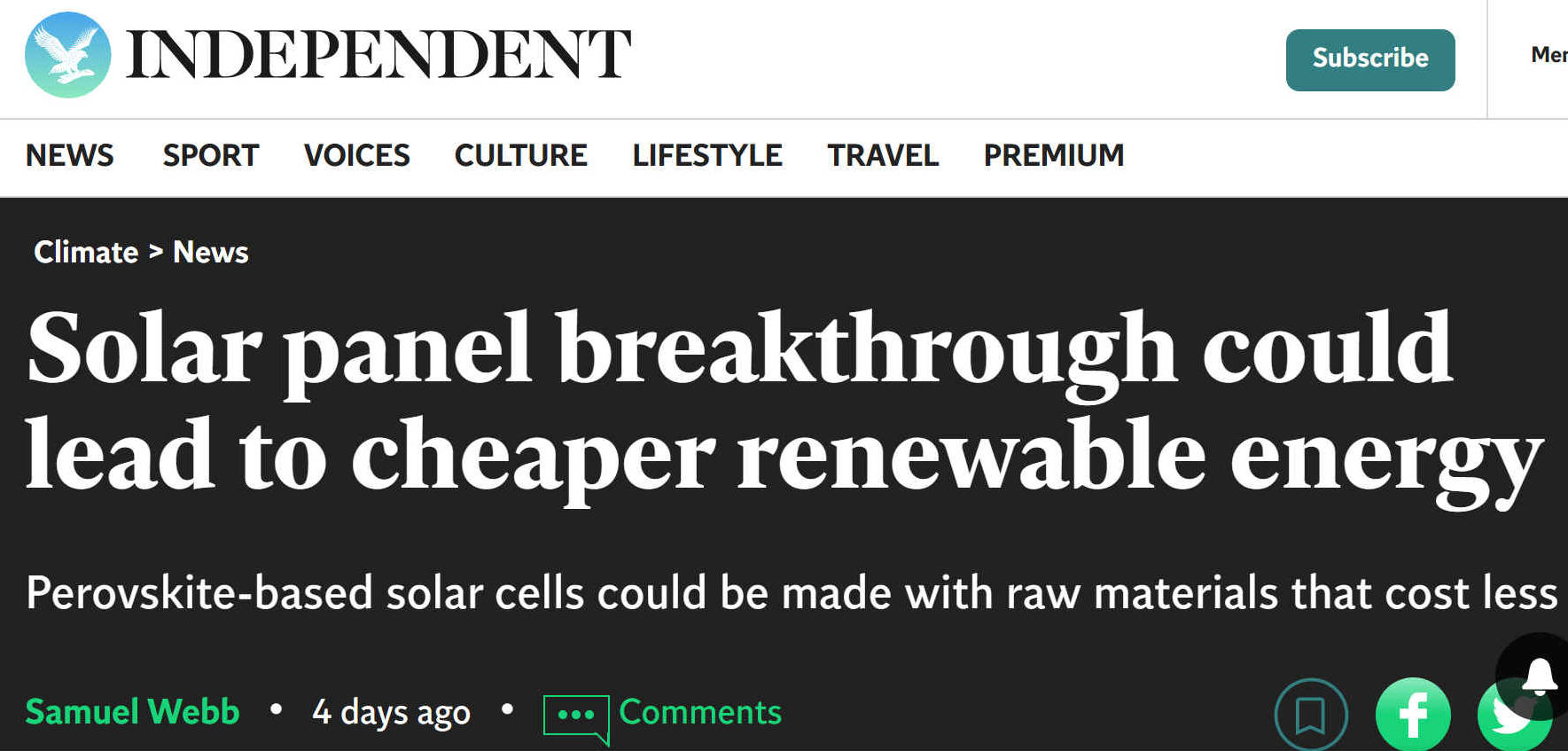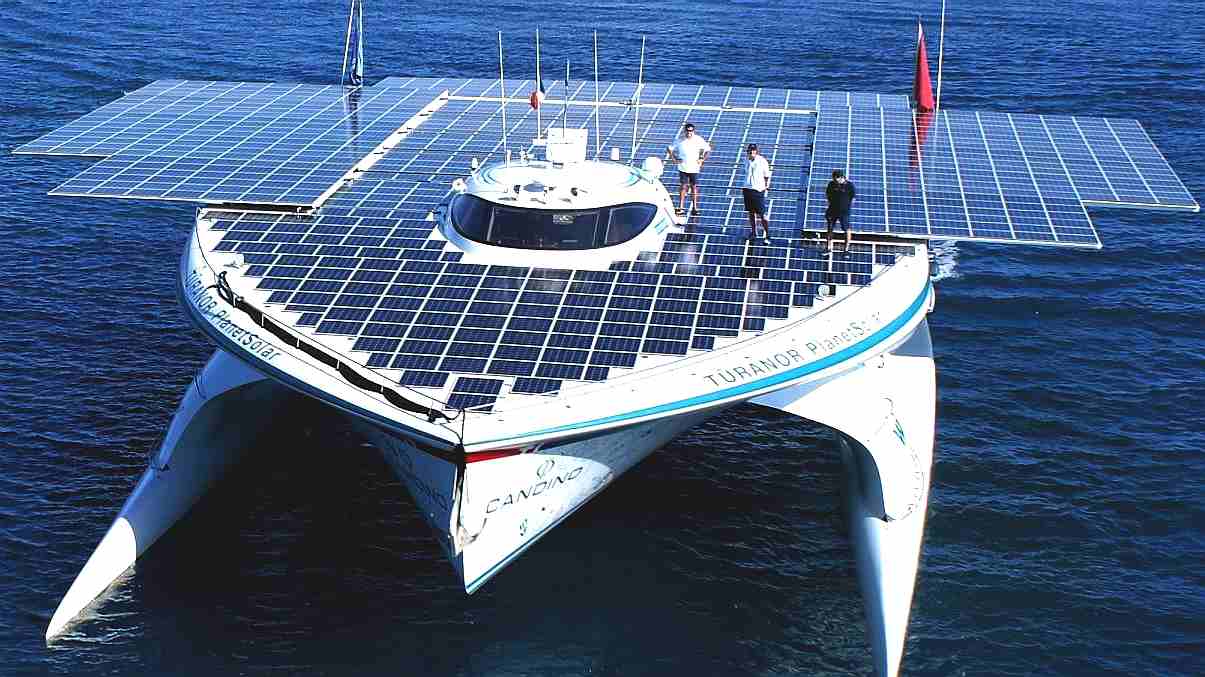|
THE INDEPENDENT 27 DECEMBER 2022 - SOLAR PANEL BREAKTHROUGH COULD LEAD TO CHEAPER RENEWABLE ENERGY
Cheaper solar panels could be on the way after a scientific breakthrough.
Using enhanced halide perovskite – a man-made material with repeating crystals shaped like cubes – in place of silicon could produce less expensive devices that stand up better to light and heat, according to researchers led by the University of California, Los Angeles (UCLA).
Solar power still accounts for a little less than 3% of electricity generated in the US in large part because of the high cost to produce solar cells.
One way to lower the cost of production would be to develop solar cells that use less-expensive materials than today’s silicon-based models, the researchers claim. To achieve that, some engineers have zeroed in on halide perovskite, a type of human-made material with repeating crystals shaped like cubes.
In theory, perovskite-based solar cells could be made with raw materials that cost less and are more readily available than silicon; they also could be produced using less energy and a simpler manufacturing process.
“Renewable energy is critically important,” said UCLA Professor Yang Yang. “Perovskite will be a game changer because it can be mass produced in a way silicon cannot, and we’ve identified an additive that will make the material better.”
A stumbling block has been that perovskite breaks down with exposure to light and heat — particularly problematic for devices meant to generate energy from
the
sun.
But the UCLA team has developed a way to use perovskite in solar cells while protecting it from the conditions that cause it to deteriorate. In a study that was published recently in Nature Materials, the scientists added small quantities of ions — electrically charged atoms — of a metal called neodymium directly to perovskite.
They found not only that the augmented perovskite was much more durable when exposed to light and heat, but also that it converted light to
electricity more efficiently.
“The ions tend to move through the perovskite like cars on the highway, and that causes the material to break down,” Zhao said. “With neodymium, we identified a roadblock to slow down the traffic and protect the material.”
In June 2016, researchers from Manchester University in England unveiled a new solar cell made from perovskite crystals.
To make a long story short, solar cells made from perovskite crystals can be as much as 20% more efficient than solar cells made from silicon. Perovskite solar cells have only been around since 2009, but they are quickly gaining traction.
MULTI JUNCTION SOLAR CELLS
Multi-junction solar cells are capable of a higher power conversion efficiency (PCE), increasing the threshold beyond the thermodynamic maximum set by the Shockley–Queissier limit for single junction cells. By having multiple bandgaps in a single cell, it prevents the loss of photons above or below the band gap energy of a single junction solar cell. In tandem (double) junction solar cells, PCE of 31.1% has been recorded, increasing to 37.9% for triple junction and 38.8% for quadruple junction solar cells. However, the metal organic chemical vapor deposition (MOCVD) process needed to synthesize lattice-matched and crystalline
solar cells with more than one junction is very expensive, making it a less than ideal candidate for widespread use.
Perovskite semiconductors offer an option that has the potential to rival the efficiency of multi-junction solar cells but can be synthesized under more common conditions at a greatly reduced cost. Rivalling the double, triple, and quadruple junction solar cells mentioned above, are all-perovskite tandem cells with a max PCE of 31.9%, all-perovskite triple-junction cell reaching 33.1%, and the perovskite-Si triple-junction cell, reaching an efficiency of 35.3%. These multi-junction perovskite solar cells, in addition to being available for cost-effective synthesis, also maintain high PCE under varying weather extremes – making them utilizable worldwide.
PROCESSING
Perovskite solar cells hold an advantage over traditional silicon solar cells in the simplicity of their processing and their tolerance to internal defects. Traditional silicon cells require expensive, multi-step processes, conducted at high temperatures (>1000 °C) under high vacuum in special cleanroom facilities. Meanwhile, the hybrid organic-inorganic perovskite material can be manufactured with simpler wet chemistry techniques in a traditional lab environment. Most notably, methylammonium and formamidinium lead trihalides, also known as hybrid perovskites, have been created using a variety of solution deposition techniques, such as spin coating, slot-die coating, blade coating, spray coating, inkjet printing, screen printing,
electro-deposition, and vapor deposition techniques, all of which have the potential to be scaled up with relative ease except spin coating.
Scalability includes not only scaling up the perovskite absorber layer, but also scaling up charge-transport layers and electrode. Both solution and vapor processes hold promise in terms of scalability. Process cost and complexity is significantly less than that of silicon solar cells. Vapor deposition or vapor assisted techniques reduce the need for use of further solvents, which reduces the risk of solvent remnants. Solution processing is cheaper. Current issues with perovskite solar cells revolve around stability, as the material is observed to degrade in standard environmental conditions, suffering drops in efficiency.
In 2014, Olga Malinkiewicz presented her inkjet printing manufacturing process for perovskite sheets in Boston (US) during the MRS fall meeting – for which she received MIT Technology review's innovators under 35 award. The University of Toronto also claims to have developed a low-cost Inkjet solar cell in which the perovskite raw materials are blended into a Nanosolar ‘ink’ which can be applied by an inkjet printer onto glass, plastic or other substrate materials.
|

